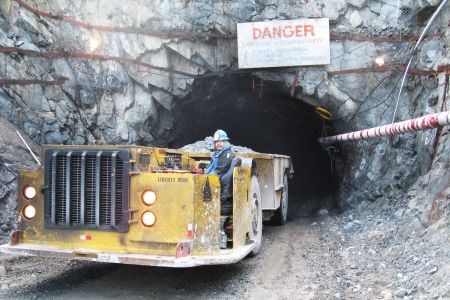Liberty Mines is a dirty name in mining circles, and Chris Stewart knows it.
Following years of inconsistent production at its Timmins nickel operations, Liberty's tailings pond was declared full in February—several years before its predicted shelf life—and its reputation took a nosedive, leaving shareholders fuming and the company in disarray.
That notoriety preceded Stewart's address at the Dec. 2 annual general meeting of the Sudbury Area Mining Supply and Service Association (SAMSSA), and he was clearly nervous about the reception he would receive.
“I know Liberty's had a bit of a sordid past,” said the company's new president and CEO. “I'm hoping today that you leave here with a better view of the company and understand what we're doing to try and re-establish ourselves in the nickel business.”
After completely overhauling its senior and on-site management staff—only the mill superintendent was spared the chopping block—Liberty is hoping to regain a foothold in the nickel-mining business by starting production at its Redstone and McWatters Mines, planning for the construction of a new mine in 2012, and strategizing for exploration at its Groves property.
Chinese nickel company Jilin Jien currently holds a 60 per cent stake in Liberty, but Stewart indicated the company is keen to reduce its interest to between 25 and 30 per cent, with no plans to purchase the company in its entirety.
Relocating to the North is akin to a homecoming for Stewart, who previously worked for Lakeshore Gold and lived for a decade in Sudbury before taking on the position of manager of shaft projects for BHP Billiton's 3,370 million-tonne Jansen potash project in Saskatchewan.
After joining Liberty Mines in May, Stewart was given the mandate to implement a turnaround strategy and “get this company squared away.”
He identified strengthening supplier relationships as a priority, in addition to running a streamlined operation that inspires confidence in stakeholders ranging from shareholders to employees.
“Our goal is when we restart operations, to make sure we can maintain continuous operations, not be starting and stopping,” Stewart said. “If you want to attract good people to come work for you, they need to understand that they're going to have a job for more than six months.”
With 12 to 16 months of production left at the McWatters Mine, located 29 km southeast of Timmins, focus will shift to Redstone, situated west of McWatters, where 750,000 tonnes of ore at 1.6 per cent nickel are still in situ, Stewart said.
A headframe sitting at 80 per cent completion remains from 2007 when nickel prices soared, and Stewart estimated it might be feasible to sink a shaft in a few years' time. However, the “real gem” for Liberty is below the 1,600 level, where there exist “a number of tonnes at a pretty good grade,” Stewart said.
He predicted Liberty's future lies with the Hart Mine, slated for construction in 2012, for which Stantec is currently undertaking a feasibility study. A 2008 resource estimate indicated 1.39 million tonnes grading 1.5 per cent nickel and inferred 286,000 tonnes grading 1.36 per cent nickel.
“There's some interesting stuff we found at Hart,” Stewart said. “We hit another deposit 300 metres east of the main Hart deposit, so there's the potential to build it out into something larger than what we originally anticipated.”
Work at McWatters may be contracted out so the company can focus on Hart's development.
That Liberty has its own mill and concentrator gives the company a leg up over other miners, Stewart added. The mill can currently process 1,500 tonnes per day, but permitting is underway to increase that to 2,000 tonnes. The company has spent $1.4 million on the mill so that it's ready to go when production starts up in the first quarter of 2012.
As to the pesky tailings pond that kickstarted Liberty's resurgence, Stewart said the company has engaged consulting firm Kohn Crippen Berger to devise a solution.
“We've come up with a plan where we're basically going to raise the dam and give ourselves three years' worth of life,” Stewart said. “We realize that's not long enough, but it buys us the time we need to go through an environmental baseline study, permit a new tailings pond and actually construct that.”
The new pond, estimated to be in place by 2014, will encompass an estimated life of 50-plus years so that it can handle the available resources identified by the company, he added.
As the company rises out of its funk, Stewart said it's simultaneously working on a new competitive tendering process, and is aiming to have three drills running next year, an increase from one.
Liberty is seeking an opportunity to repair its fractured relationships and is hopeful stakeholders will give it that opportunity.
“Liberty is here for the long haul,” Stewart said. “We're looking to be a responsible company dealing with suppliers, dealing with the environment, dealing with the government. We're not here to take shortcuts.”




